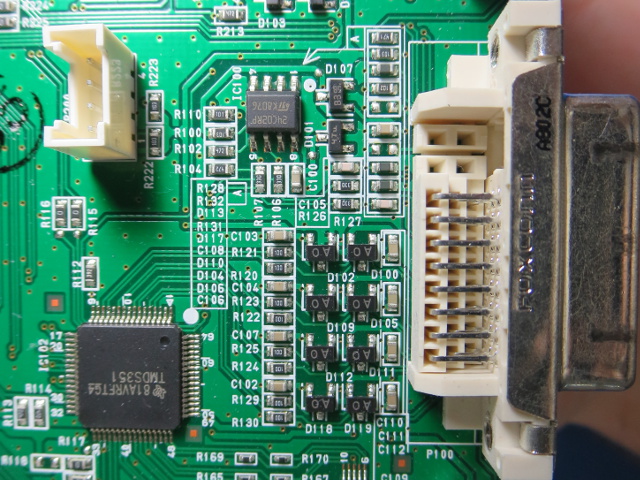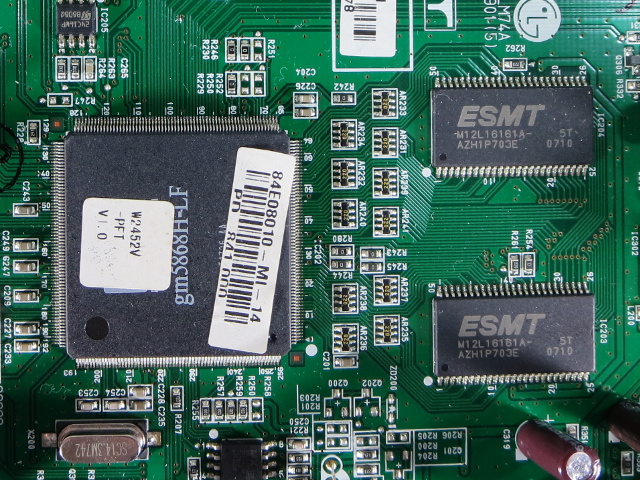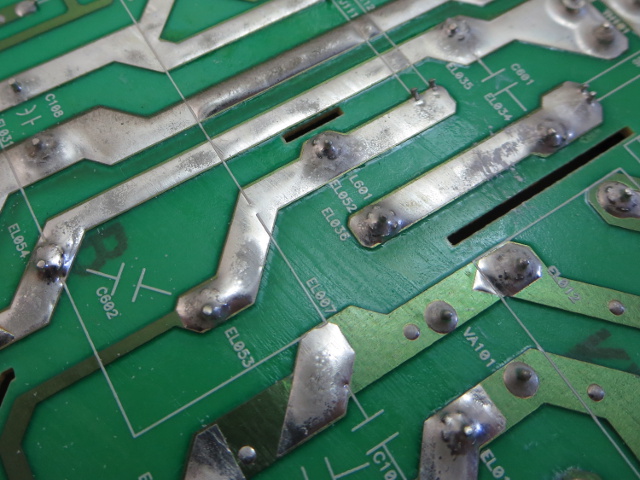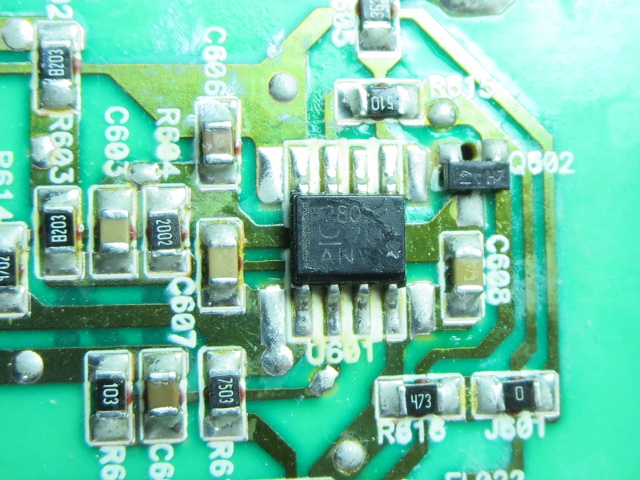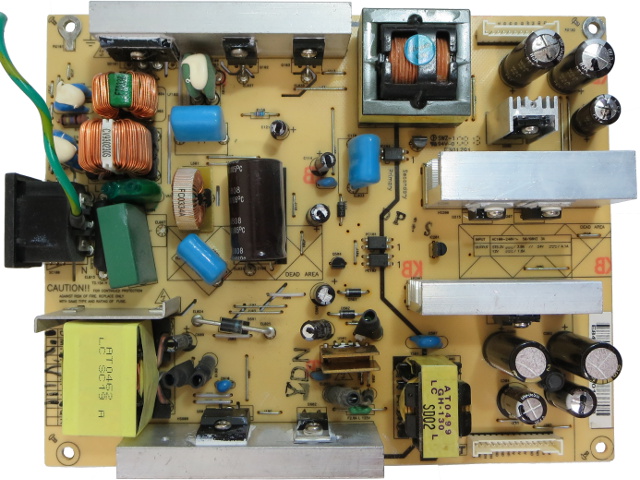LG W2452V 24-Inch Monitor Tear-Down And Repair
A Link To The Past
VGA input may have fallen out of favor, but it still makes for pretty PCB layouts from the neatly ordered resistor-capacitor (RC) low-pass filters on the left to the resistor-capacitor-diode (RCD) input protection to the right. DDI on the VGA port is provided by a 2Kb STMicro 24C02RP I2C EEPROM, which is the same for DVI and HDMI.
A Look At The DVI Input
The DVI input protection looks somewhat similar, despite being digital-only. At the top-mid, we see the DDI chip and its own protection circuitry. Below and starting from the right, we have some decoupling caps for the input protection, input clamping diodes and series termination resistors with more decoupling caps in between signal pairs. A TI TMDS351 triple-input DVI/HDMI switch occupies the bottom-left corner, though only two of its inputs are implemented on this PCB.
… And The HDMI Input
Things look much simpler on HDMI's side. I could not find information about that D1380747 part, but seeing how all four TMDS signal pairs go straight to it on their way to their respective resistors and the TI mux beyond, I would bet it is simply an integrated octuple diode clamp network in lieu of the discrete networks seen on the DVI and VGA inputs. Of course, we also have the third of those DDI EEPROMs near the bottom-left with its own support components scattered more loosely than the other two ports.
Let There Be Sound!
The audio coming out of the rear 3.5mm audio jack has to originate somewhere. That'd be a Cirrus Logic CS4352 24-bit 192ksps DAC with 96dB THD+N, which is on par with the theoretical maximum for CD audio. I have never used it before, though at a glance this looks like a neat and tightly-packed layout located out of the way from obvious ground current paths, so I would expect reasonably clean output.
I briefly listened with the first earphones I could find, and while I did not hear obvious noise or distortion at low volume, the output did start having obvious clipping with the volume set as low as 20% in Windows, which corresponded to loudness somewhat above normal for me.
Controller Chip And Friends
The display controller is an STMicro gm5868 with the required external DRAM chips to support frame rate conversion. While ST's specifications say only 75MHz 16x512k (yes, that's 1MiB) SDRAM is required, LG uses 200MHz ESMT M12L16161A-5T chips, likely because slower low-density SDR memory was effectively extinct when the board was manufactured in 2008.
The small chip partially cropped off at the bottom is a Macronix MX25L4005 4Mb serial NAND device to store the display manufacturer's UI bitmap resources, and the other chip at the top is a 16Kb STMicro 24C16WP I2C EEPROM to store user settings.
Get Tom's Hardware's best news and in-depth reviews, straight to your inbox.
And Now, The Main Course
I said this was a (reverse) tear-down and repair, and I have not shown anything repair-ish yet. We're getting there.
Since the PCB is single-sided, all of the surface-mount components are located on the bottom, including two integrated circuits. The top IC is obviously the PWM regulator for the 12V and 24V outputs, while the smaller chip near the bottom-right corner does active power factor correction.
Now That's Convenient
All of the major top-side components and every jumper link are silkscreened on the bottom for easy signal tracing and troubleshooting. The silkscreen also interrupts some solder puddles by acting as a presumably unintended solder mask. Apart from that, soldering quality looks quite good overall.
Scarface
Markings on the APFC chip must have seen better days: it looks like small flakes chipped off the packaging. Skinny dipping through a molten solder fountain can do that to you.
Searching for APFC controllers in SOIC-8 packaging with “280” in their model number spits out TI's UCC28051D as the most likely candidate. At a glance, the pin-out looks like a probable match.
Going On Top
Looking at either side of the board, most of the power handling path is obvious. Power arrives at the IEC plug on the left, goes up through the input filtering, passes through the bridge rectifier on the top heat sink, starts its way back down through PTCs, some more filtering with a choke and film caps, the APFC circuit in the bottom-left corner and then back up along the isolation boundary to feed the two output regulators.
Can you spot the issues from this angle?
Ratings
If you ever want to reuse this display's power supply for something else, the input and output ratings are all conveniently printed on the board.
In the top-left corner, we also see that this board was manufactured during the 13th week of 2008, just like the CCFL one. The UL listing just below the manufacturing date tells us the PCB was made by Shanghai Wanzheng Circuit Board Co. Ltd., and has passed 94V-0 flammability tests.
-
iam2thecrowe I normally find in Samsung monitors a Samxon capacitor leaking. I swear monitor manufacturers put them in on purpose as a time-bomb capacitor. They fail after about 5 years, long enough that you thought, ok well i had a good run, but not short enough that it is an early failure. Its good to see an article like this, many monitors can be saved this way if you have a little soldering skill.Reply -
coolkwc Bad cap again...the cheapest yet effective time bomb of all components. Seldom got ppl want to dismantle dead old monitor even they have solder skill, simply because dismantle process before you can access to that tiny component itself already stopped alot of ppl ambitious. So i say this is effective time bomb to kill the device.Reply -
iam2thecrowe Reply15491836 said:Bad cap again...the cheapest yet effective time bomb of all components. Seldom got ppl want to dismantle dead old monitor even they have solder skill, simply because dismantle process before you can access to that tiny component itself already stopped alot of ppl ambitious. So i say this is effective time bomb to kill the device.
I generally have no problem getting anything apart and it only takes a few minutes. But yea i agree with this a little, a HP monitor i recently tried to fix was held together with noting but plastic clips, it was not designed to be taken apart once assembled. The plastic clips often break and they don't go back together 100%. -
crmaris When you want to check which capacitor is preventing a PSU (embedded in a device or a standalone) from starting try heating the ones that look defective with the heating iron. The bad cap once heated will allow the PSU to start and then you will know which one is bad.Reply
If you want a more scientific way then you should get an ESR meter. I have seen many caps that weren't bulged but still were bad (high ESR). -
coolkwc Basically none of them except those 'audiophile' equipment and PC component hear about our rant over internet/forum about badcap. Consumer product they often use dirt cheap component to maximize their profit. Nowadays especially those Japanese and Korean brand, they just provide design, and left manufacturing process (material decision) to those China maker, so basically Japanese and Korean device = China brand. A good example is Panasonic product never use a single piece of capacitor from its own brand or any other Japanese brand despite the fact that its capacitor is highly reputable. What a shame.Reply -
Daniel Sauvageau Reply
To use an ESR meter properly, you have to remove the caps from the circuit first and that's half of the replacement job for a cap you are already suspecting might be bad to start with. I went with the "targets of opportunity" strategy there: I'm already elbows-deep into this thing, might as well replace all potential suspects while I am in there instead of discovering a few more years down the road that another one that I skipped decided to go bad.15491955 said:If you want a more scientific way then you should get an ESR meter. I have seen many caps that weren't bulged but still were bad (high ESR).
If you paid someone $75-100 to repair an LCD, would you risk having to pay for having it repaired again 3-4 years due to skipping a $5 ($1 part + $4 time) opportunistic part replacement?
As far as the caps from my previous repair in this monitor go, I would be really surprised if they went bad without external signs since Panasonic is a far more reputable capacitor brand and the caps I used have much better specs than Samwha's. I repaired a bunch of PSUs using Panasonic FM-series caps and none of them have as far as I know.
If I had an ESR/ESL meter, I might have pulled one out just to see how the three years used FMs compare against fresh ones.
The most difficult part is prying the bezel off to remove the LCD from its enclosure. That part alone took me about an hour the first time since I did not know what sort of snap arrangement was used and there were no broken snaps to give me easier starting points. When I opened it up to do finish the repair this time around, I could have been in and out in about an hour, were it not for the hours spent taking photos for the tear-down.15492329 said:Nice article. How much time did you spend repairing it?
The repair itself only takes a few minutes once you have access to the PCB when you have a strong suspect before you even open the device and are going straight for it before investigating anything else.
-
cats_Paw ReplyI normally find in Samsung monitors a Samxon capacitor leaking. I swear monitor manufacturers put them in on purpose as a time-bomb capacitor. They fail after about 5 years, long enough that you thought, ok well i had a good run, but not short enough that it is an early failure. Its good to see an article like this, many monitors can be saved this way if you have a little soldering skill.
Em... yeah its called Planned obsolescence, nothing new, just another way most people are getting F'ed and dont know it. -
razor512 Many monitors now use lower quality capacitors in order to shorten the lives.Reply
Some will even design the boards around a more difficult repair, for example acer likes to sometimes completely flatten the leads against the PCB before soldering, thus it becomes annoying to desolder.
Here is the repair I did on my acer x191w a while back https://www.youtube.com/watch?v=hLbSbhvTTgY
PS, even on some relatively high quality brands, you will often fine a few cheap capacitors used in order to shorten the life of the panel.
The same also applies to many HDTV's
If the capacitors do not have the leads completely bent, then you are looking at about 40 seconds to a minute to replace each bad capacitor, if they are bent, then it takes much longer because there is always a little bit of solder left over, and you do not want to pull, even if you see a tiny bit as you do not want to damage the solder pads.
While the companies know that some people will do a repair them self, they know that the vast majority of people will not want to do the repair them self. Thus using a design that is is centered around being harder to fix, will prevent them from going to a 3rd party repair service, as the work involved will make the repair costs too high to justify it as compared to just getting a new device. -
JayTs Years ago my Acer monitor died after only 18 months, and I did a repair like this one. I had never opened a flat screen monitor and was amazed at the cheap construction, being held together by wimpy plastic clips and sticky tape. I found failed capacitors and decided to replace all of the caps with high-quality Nichicons. Four years later, the monitor is still working perfectly, running about 16 hours per day.Reply
For anyone who wants to try this type of repair, you need to know the following specs of each capacitor:
1. Capacitance (microfarads or uF). Match or exceed the original.
2. Rated voltage. Match or exceed the original.
3. Diameter and length. You may use a different size if you are sure it will fit.
4. Lead spacing. Measure the distance between the leads from the cap or holes in the PCB.
As explained in the article, capacitors in the power supply should be chosen to handle high ripple current and/or low ESD as necessary.
Once you have the information, it's complicated but not too difficult to find replacements at Mouser, Digi-Key, or other reputable electronic component distributors. Pick a top brand like Panasonic, Nichicon (my two personal favorites). Look for "Aluminum Electrolytic Capacitors - Leaded" or similar.
To replace all of the capacitors in my monitor, I spent about $15.
With good quality capacitors, how long can a monitor last? Who knows?

